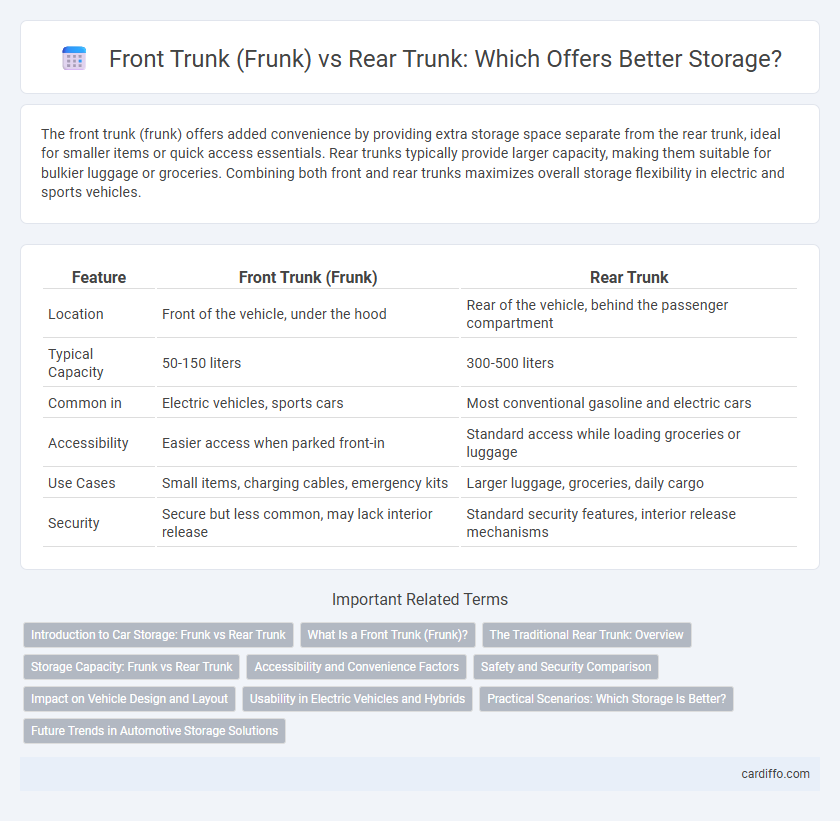The front trunk (frunk) offers added convenience by providing extra storage space separate from the rear trunk, ideal for smaller items or quick access essentials. Rear trunks typically provide larger capacity, making them suitable for bulkier luggage or groceries. Combining both front and rear trunks maximizes overall storage flexibility in electric and sports vehicles.
Table of Comparison
| Feature | Front Trunk (Frunk) | Rear Trunk |
|---|---|---|
| Location | Front of the vehicle, under the hood | Rear of the vehicle, behind the passenger compartment |
| Typical Capacity | 50-150 liters | 300-500 liters |
| Common in | Electric vehicles, sports cars | Most conventional gasoline and electric cars |
| Accessibility | Easier access when parked front-in | Standard access while loading groceries or luggage |
| Use Cases | Small items, charging cables, emergency kits | Larger luggage, groceries, daily cargo |
| Security | Secure but less common, may lack interior release | Standard security features, interior release mechanisms |
Introduction to Car Storage: Frunk vs Rear Trunk
The front trunk (frunk) offers additional storage space by utilizing the area under the hood, commonly found in electric vehicles due to the absence of a traditional engine. The rear trunk remains the primary storage compartment, typically larger and designed for everyday cargo needs. Comparing frunk and rear trunk capacities reveals how modern car designs optimize storage efficiency for varied user requirements.
What Is a Front Trunk (Frunk)?
A front trunk, or frunk, is a storage compartment located at the front of a vehicle, commonly found in electric cars like Tesla models and sports cars with rear engines, such as the Porsche 911. This extra space provides additional cargo capacity by utilizing the area under the hood, which is typically unoccupied in vehicles without traditional internal combustion engines. Frunks offer secure, weather-resistant storage separate from the rear trunk, enhancing overall vehicle practicality and organization.
The Traditional Rear Trunk: Overview
The traditional rear trunk remains the primary storage space in most vehicles, offering large cargo capacity suited for luggage, groceries, and bulky items. Positioned at the back, it benefits from a wide opening and deep compartment, facilitating easy loading and unloading of goods. Rear trunks typically include features like foldable rear seats to expand storage flexibility for larger cargo needs.
Storage Capacity: Frunk vs Rear Trunk
Front trunks (frunks) typically offer limited storage capacity, ranging from 2 to 5 cubic feet, designed for smaller items and easy access. Rear trunks generally provide significantly larger space, often exceeding 12 cubic feet, accommodating bulkier luggage and groceries. Vehicle design and drivetrain layout play crucial roles in determining the size and usability of both storage compartments.
Accessibility and Convenience Factors
The front trunk (frunk) offers enhanced accessibility with easier reach and loading, especially in tight parking spaces where rear access may be obstructed. Its location allows quick retrieval of smaller items without the need to open the larger rear trunk, improving everyday convenience for drivers. However, the rear trunk typically provides greater overall storage capacity, accommodating bulkier items and longer cargo for varied transportation needs.
Safety and Security Comparison
Front trunks (frunks) often provide enhanced security due to their location closer to the vehicle's cabin, reducing exposure to theft or vandalism compared to rear trunks. Many front trunks include reinforced locks and are less accessible to break-ins, contributing to safer storage of valuable items. Conversely, rear trunks can be vulnerable to tailgate breaches and may lack the same security features, making frunks a preferable option for protecting sensitive belongings.
Impact on Vehicle Design and Layout
The front trunk (frunk) enables enhanced vehicle packaging by utilizing space at the front, often resulting in improved weight distribution and increased overall cargo capacity compared to traditional rear trunks. Rear trunks remain essential for accommodating larger or bulkier items due to their typically more accessible and expansive design. Integrating a frunk influences vehicle layout by freeing rear space for passenger comfort or additional systems, while impacting cooling and crash structures in front-engine or electric vehicles.
Usability in Electric Vehicles and Hybrids
Front trunks (frunks) in electric vehicles and hybrids enhance usability by providing additional storage space separate from the rear trunk, maximizing overall cargo capacity without compromising passenger space. Frunks often offer secure, weatherproof compartments ideal for smaller items or quick access essentials, improving organizational efficiency during travel. Rear trunks typically remain larger, accommodating bulkier luggage and everyday cargo needs, making the combination of both storage areas versatile for varied usage scenarios.
Practical Scenarios: Which Storage Is Better?
Front trunks (frunks) offer unique practical advantages in electric vehicles by freeing up more rear space for passengers and bulky items, making them ideal for grocery runs or sports equipment. Rear trunks typically provide larger capacity and easier access for loading heavy or large luggage, especially in traditional combustion engine cars. In urban settings, a frunk can enhance storage flexibility by accommodating smaller items separately from the main cargo, improving organization and convenience.
Future Trends in Automotive Storage Solutions
Future automotive storage solutions increasingly emphasize maximizing space utilization through innovative front trunk (frunk) designs, especially in electric vehicles (EVs) where traditional engine space is repurposed. Advancements in modular storage systems and smart compartments enhance accessibility and adaptability in both frunks and rear trunks, addressing consumer demands for convenience and versatility. Integration of AI-driven inventory management and climate-controlled compartments represents a significant trend shaping the next generation of automotive storage.
front trunk (frunk) vs rear trunk Infographic

 cardiffo.com
cardiffo.com